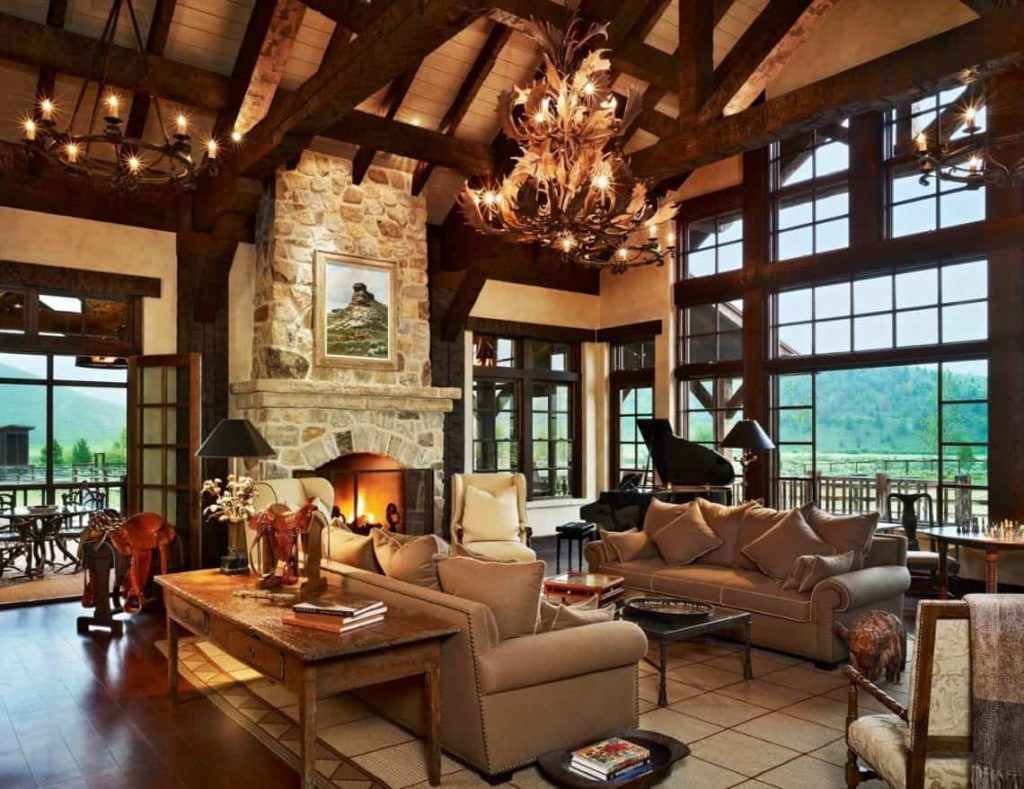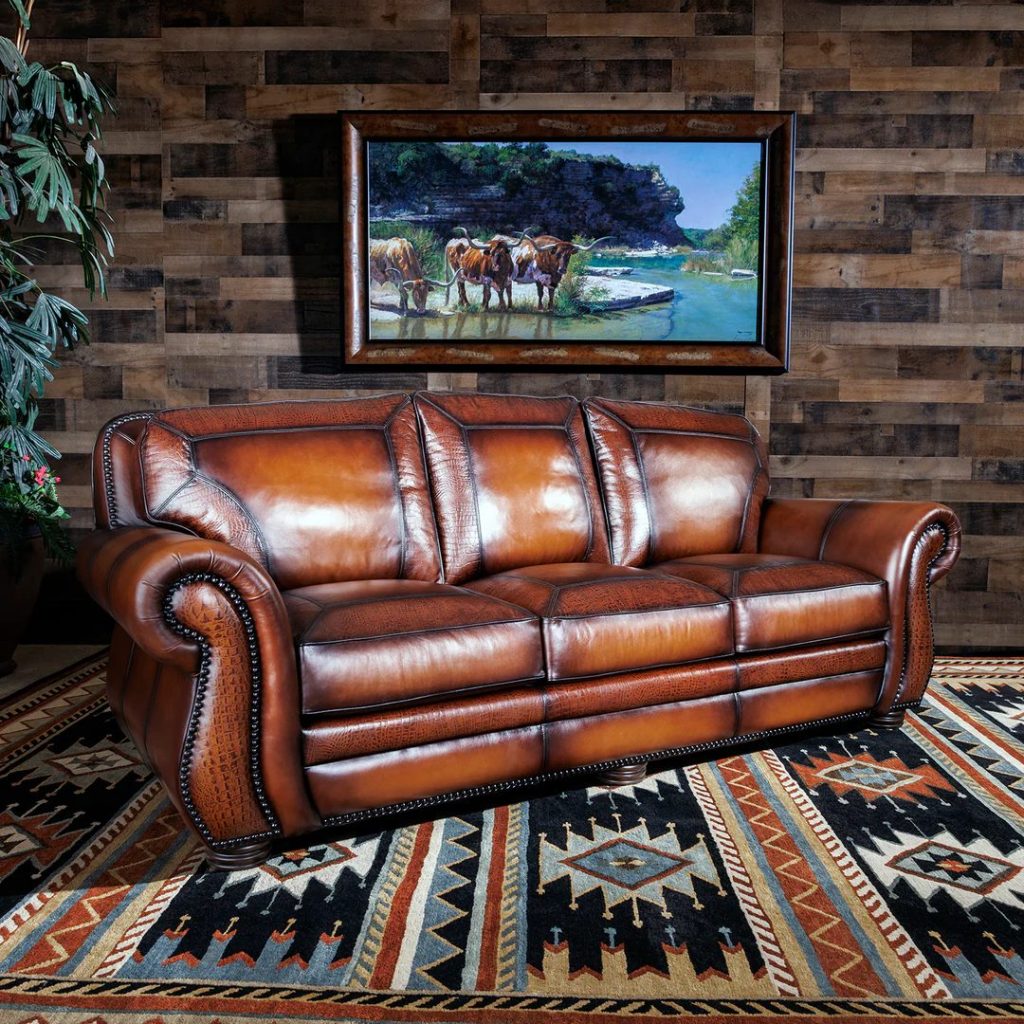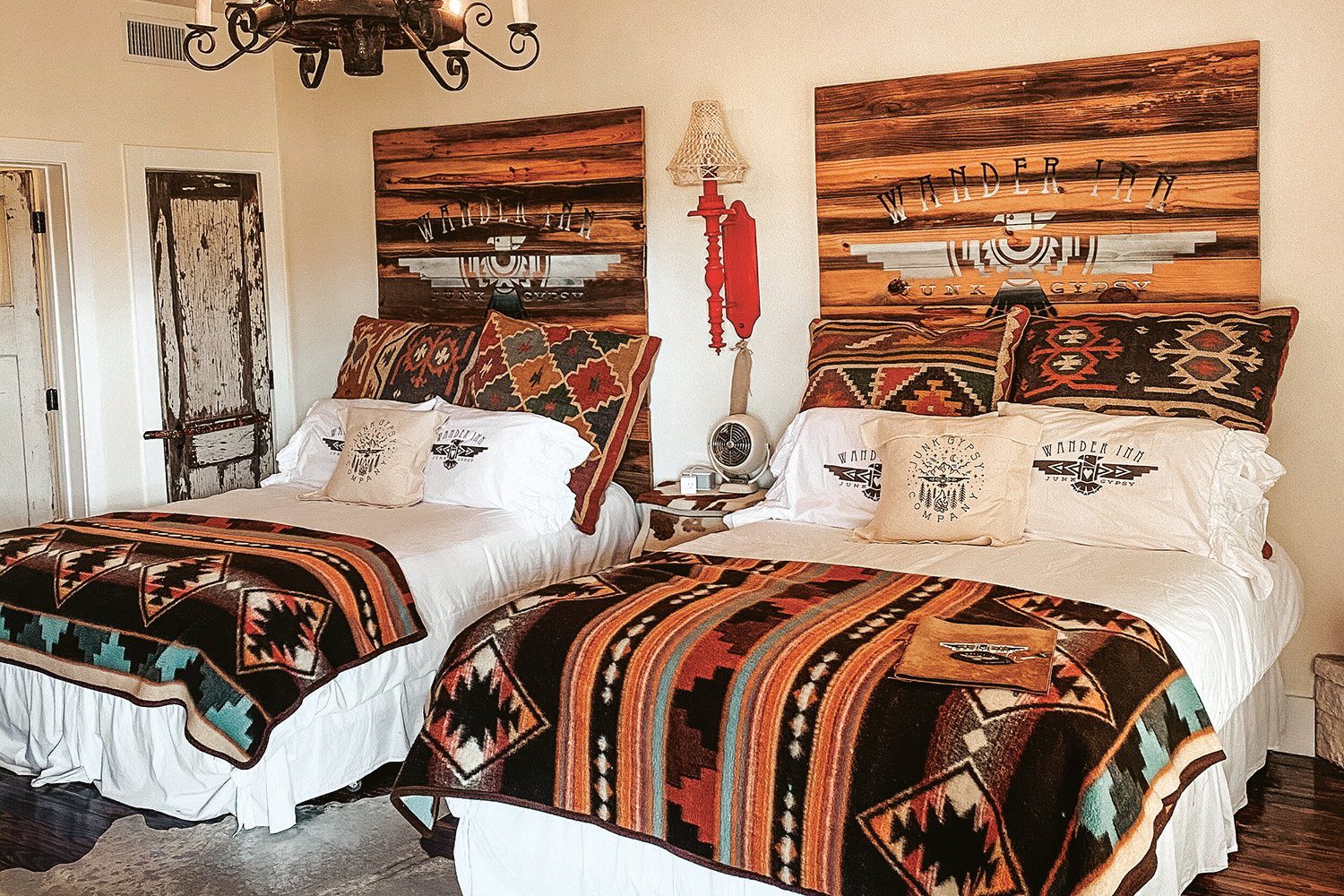Designing a western-themed room is an artful endeavor that combines rugged authenticity with sophisticated aesthetic sensibilities. The western interior design style transcends mere decoration, embodying a narrative of expansive landscapes, pioneer spirit, and timeless elegance.
From the sun-drenched plains of Texas to the rocky mountains of Wyoming, western design captures an essence of American heritage that resonates with those seeking warmth, character, and a connection to a rich cultural landscape.
Whether you’re a ranch owner, urban dweller, or design enthusiast, these fourteen western room ideas will provide you with comprehensive insights to create a space that speaks to the soul of the American West.
Western Room Ideas
By exploring various design elements, textures, and storytelling techniques, you’ll discover how to transform an ordinary room into a compelling tribute to western lifestyle and aesthetic.
1 Rustic Wooden Accents: The Foundation of Western Design

Western design fundamentally celebrates the raw beauty of natural materials, with wood playing a pivotal role in creating an authentic atmosphere. Reclaimed barn wood, weathered oak, and robust pine serve as more than mere structural elements—they are storytellers of historical narratives and rugged landscapes. The unique characteristics of each wooden piece contribute to a rich, layered design that speaks of tradition and endurance.
Consider incorporating wooden beams, distressed wooden furniture, or intricate wood paneling to infuse your space with genuine western character. The texture and grain of carefully selected wooden elements can transform an ordinary room into a compelling narrative of western heritage.
Opt for pieces that showcase natural imperfections, knots, and varied tones, which add depth and authenticity to your design. A massive wooden coffee table with iron accents or a reclaimed wood feature wall can become the centerpiece that anchors your western-inspired interior.
2 Leather Furniture: Embodying Cowboy Elegance

Leather furniture represents the quintessential western aesthetic, bridging functionality with sophisticated style. Rich, supple leather in deep browns, warm chestnuts, and occasional distressed finishes creates an immediate connection to western sensibilities. The tactile quality of leather speaks to a heritage of craftsmanship, durability, and rugged beauty that defines the western design philosophy.
The selection of leather furniture goes beyond mere visual appeal. Consider pieces that showcase traditional craftsmanship, with visible stitching, brass rivets, and robust construction. These elements not only enhance durability but also contribute to the storytelling aspect of western design.
A classic leather Chesterfield sofa or a pair of worn leather armchairs can instantaneously elevate your room’s design narrative. Pair leather furniture with subtle textile accents like wool throws or cowhide rugs to create a layered, inviting environment that feels both authentic and sophisticated.
3 Southwestern Color Palette: Earthy and Vibrant Hues
The southwestern color palette draws inspiration from the expansive desert landscapes, incorporating rich terracottas, deep oranges, muted blues, and warm neutrals. These colors reflect the natural environment of the American West, creating a harmonious and grounding atmosphere. The carefully curated palette captures the essence of sun-baked landscapes, ancient rock formations, and the vibrant cultures that have shaped the region.
Strategic color placement can dramatically transform a room’s ambiance. Consider a feature wall in a deep terracotta tone, complemented by neutral furnishings and vibrant southwestern-inspired throw pillows. The key is to balance bold colors with subtle, earthy undertones, ensuring the space feels inviting and cohesive rather than overwhelming. By thoughtfully integrating these colors through wall treatments, textiles, and decorative accessories, you can create a room that resonates with the warmth and spirit of the southwestern landscape.
4 Native American and Mexican Inspired Textiles

Textiles play a crucial role in western room design, offering opportunities to incorporate intricate patterns and cultural storytelling. Navajo-inspired blankets, Mexican serape textiles, and handwoven rugs can introduce complex geometric patterns and rich color narratives. These textiles serve as more than mere decorative elements—they are powerful expressions of indigenous artistic traditions and cultural heritage.
When incorporating these textiles, balance is paramount. Use them as statement pieces—perhaps as wall hangings, throw blankets, or carefully curated cushion covers. Their intricate designs can provide visual complexity without overwhelming the overall design aesthetic. Each textile tells a story of craftsmanship, tradition, and the vibrant cultural tapestry of the American Southwest. By selecting pieces that resonate with authenticity and artistic excellence, you can create a space that honors the rich textile traditions of western cultures.
Related Guide: 15 Perfect Western Bathroom Ideas
5 Antler and Horn Decor: Natural Sculptural Elements

Antler and horn decor represents a quintessential western design element, bringing natural sculptural intrigue to interior spaces. Whether utilizing authentic shed antlers or high-quality replicas, these elements can be incorporated through chandeliers, wall mounts, or decorative table pieces. They symbolize a deep connection to nature, the hunting traditions of western culture, and the raw beauty of wildlife that defines the region.
Careful placement is essential to prevent these pieces from appearing overly rustic or cliché. Consider mixing antler elements with refined furniture and sophisticated textiles to create a balanced, modern western aesthetic that feels intentional and curated. The goal is to use these natural elements as sophisticated design accents that add depth, texture, and a sense of organic complexity to your interior space. Thoughtful integration can transform antler and horn decor from simple decorative objects to compelling design statements.
6 Western Art and Photography

Artwork serves as a powerful narrative tool in western room design. Landscape paintings capturing vast prairie scenes, black and white cowboy photography, and traditional western genre art can transform walls into storytelling canvases. These visual elements provide more than mere decoration—they offer windows into the cultural landscape, historical moments, and the expansive spirit of the American West.
Consider creating a gallery wall that combines different artistic mediums and styles, allowing for visual complexity and personal expression. Mix vintage photographs with contemporary western-inspired artwork to create a dynamic and engaging visual experience. Each piece should be selected not just for its aesthetic appeal, but for its ability to contribute to the broader narrative of western design. By curating art that resonates with personal connections and cultural significance, you can create a space that tells a rich, nuanced story.
7 Industrial Metal Accents

Industrial metal elements introduce an urban-western aesthetic, bridging traditional rustic design with contemporary sensibilities. Wrought iron light fixtures, copper accent tables, and steel-framed furniture can provide structural contrast to wooden and leather elements. These metallic touches add a modern edge that speaks to the evolving nature of western design, reflecting both historical roots and contemporary innovation.
Strategic metal integration prevents the space from feeling overly heavy or traditional. Look for pieces with clean lines and minimal ornamentation to maintain a sophisticated western aesthetic. The key is to use metal accents as focal points that draw the eye and create visual interest, while maintaining the overall warmth and organic feel of the western design philosophy. By carefully selecting and positioning these industrial elements, you can create a space that feels both timeless and cutting-edge.
8 Cowhide and Leather Rugs

Flooring plays a significant role in western room design, with cowhide and leather rugs offering textural intrigue and authentic western character. These natural materials introduce organic shapes and rich textures that complement wooden and leather furniture. Each rug tells a story of craftsmanship, connection to nature, and the distinctive aesthetic of western design.
Consider layering different textures and sizes to create visual depth. A large cowhide rug can serve as a foundational piece, while smaller leather or woven rugs can define specific areas within the room. The varied patterns, natural variations, and rich textures of these rugs add complexity and visual interest to your interior space. By selecting high-quality pieces that showcase the natural beauty of these materials, you can create a floor covering that is both functional and a work of art.
9 Western Lighting Solutions

Lighting in western-inspired rooms should balance functionality with atmospheric storytelling. Consider wrought iron chandeliers, copper pendant lights, and table lamps featuring leather or ceramic bases. These lighting elements are more than mere illumination sources—they are design statements that contribute to the overall narrative of your western-inspired space.
Incorporate dimmer switches to allow for nuanced lighting control, enabling the creation of different atmospheres throughout the day and evening. The right lighting can transform a room, casting warm, inviting glows that highlight architectural features, artwork, and carefully selected design elements. By treating lighting as an integral part of your design strategy, you can create a space that feels dynamic, adaptable, and deeply atmospheric.
10 Ranch-Inspired Accessories

Carefully curated accessories can elevate a western-themed room from basic design to a sophisticated narrative. Vintage riding equipment, old maps, classic western novels, and carefully selected decorative objects can introduce personal history and cultural depth. These pieces are more than decorative elements—they are conversation starters that provide glimpses into personal stories and cultural traditions.
The key is restraint—select pieces that genuinely resonate with the overall design concept rather than cluttering the space with generic western memorabilia. Each accessory should have a purpose, whether functional or purely aesthetic, and contribute to the room’s broader narrative. By choosing items with personal significance or historical value, you can create a space that feels authentic, personal, and richly layered.
11 Natural Stone Elements

Incorporate natural stone elements to add geological authenticity to your western room design. Sandstone fireplace surrounds, granite countertops, or slate accent walls can introduce earthy textures that complement wooden and leather elements. These stone features serve as visual anchors, connecting interior spaces to the broader geological landscape of the American West.
The selection of stone elements should be intentional and harmonious with other design components. Consider the color, texture, and natural variations of different stone types, choosing pieces that enhance rather than compete with existing design elements. By integrating natural stone thoughtfully, you can create a sense of permanence, solidity, and connection to the earth that is fundamental to western design principles.
Related Guide: 15 Inspiring Western Living Room Ideas
12 Rustic Window Treatments

Window treatments in western-inspired rooms should emphasize natural materials and craftsmanship. Consider leather-trimmed curtains, woven wooden blinds, or handcrafted textile panels that filter light while maintaining a connection to western design principles. These treatments are not merely functional but serve as additional layers of texture and storytelling.
The right window treatment can dramatically transform a room’s atmosphere, softening harsh light and creating a sense of warmth and intimacy. Choose materials and styles that complement other design elements, ensuring a cohesive look that feels intentional and carefully curated. By treating windows as important design opportunities, you can enhance the overall western aesthetic of your space.
13 Indoor Plants and Natural Elements

Integrate indoor plants that reflect western botanical landscapes. Succulents, cacti, and drought-resistant plants can introduce living elements that complement the earthy color palette and natural materials. These plants are more than decorative—they are living representations of the resilient, adaptable spirit of the western landscape.
Carefully consider placement, pot selection, and the overall composition of your indoor plants. Choose containers that align with your western design aesthetic, such as terracotta pots, woven baskets, or rustic ceramic vessels. By treating plants as design elements rather than mere decorations, you can create a dynamic, breathing space that feels connected to the natural world.
14 Personal Storytelling through Design

Ultimately, western room design is about personal narrative. While these guidelines provide a framework, the most compelling spaces reflect individual stories, memories, and connections to western culture. Each design choice should be a deliberate expression of personal experience and cultural appreciation.
Embrace the opportunity to infuse your space with elements that speak to your unique journey. Whether through family heirlooms, travel mementos, or carefully selected design elements, your western-inspired room should tell a story that is distinctly and authentically yours. The most powerful design transcends trends, creating spaces that feel deeply personal and emotionally resonant.
Conclusion
Crafting a western-inspired room is an intimate journey of design and personal expression. By thoughtfully integrating natural materials, authentic textiles, and carefully selected decorative elements, you can create a space that transcends traditional design boundaries.
Remember that the most compelling western rooms are those that balance historical reverence with personal creativity, telling a unique story through every carefully chosen element.
The essence of western design lies not in strict adherence to rules, but in capturing a spirit of authenticity, resilience, and connection to both cultural heritage and personal narrative. As you embark on this design journey, allow yourself the freedom to interpret, innovate, and create a space that truly feels like home.

